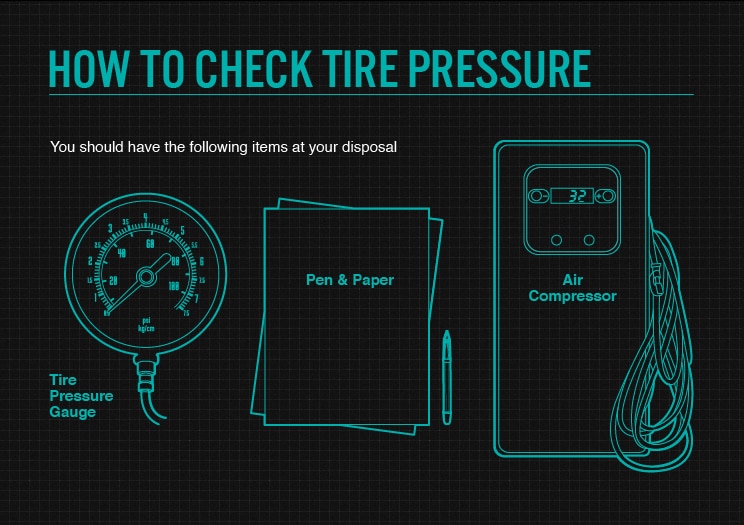How to Check Accuracy of Tire Pressure Gauge
To check the accuracy of a tire pressure gauge, simply compare it with a calibrated reference gauge. Ensure both gauges are properly connected to the tire valve, then check if the readings match.
This method guarantees accurate results. Proper maintenance of tire pressure is crucial for ensuring vehicle safety and extending tire lifespan. Monitoring the tire pressure regularly is essential. However, without an accurate tire pressure gauge, achieving this can be challenging. Inaccurate tire pressure gauges can lead to underinflation or overinflation, resulting in reduced fuel efficiency, uneven tire wear, and compromised handling.
Therefore, it is crucial to have a reliable method to verify the accuracy of a tire pressure gauge. We will explore various ways to check the accuracy of your tire pressure gauge effectively and accurately.
Importance Of Tire Pressure
Maintaining accurate tire pressure is crucial for vehicle safety and performance. To check the precision of a tire pressure gauge, it’s recommended to compare readings with those from a calibrated gauge. This ensures that you can rely on the gauge when it comes to monitoring tire pressure.
Safety
Keeping your tire pressure at the recommended level is crucial for safety on the road.
Fuel Efficiency
Correct tire pressure helps in maintaining fuel efficiency and saves you money.
“` The Importance of Tire Pressure: Maintaining correct tire pressure is essential for your safety and the durability of your vehicle. Proper tire inflation ensures optimal grip and handling, especially during braking and cornering. It also minimizes the risk of tire blowouts. Additionally, suitable tire pressure contributes to fuel efficiency by reducing rolling resistance, which means your car uses less fuel. This not only saves money but also helps the environment by reducing carbon emissions. Properly inflated tires also extend their lifespan, saving you from the cost of premature replacements.
Credit: www.motor1.com
Choosing The Right Tire Pressure Gauge
When it comes to maintaining your vehicle’s tire pressure, choosing the right tire pressure gauge is crucial. This simple tool can help you ensure that your tires are properly inflated, promoting safety and improving fuel efficiency. There are two main types of tire pressure gauges to consider: digital and analog. Let’s explore the differences between the two and how they affect the accuracy and precision of your tire pressure readings.
Digital Vs. Analog
One of the first decisions you’ll need to make when selecting a tire pressure gauge is whether to opt for a digital or analog model. Both have their pros and cons, and understanding them can help you make an informed choice.
Accuracy And Precision
Accuracy and precision are essential factors to consider when it comes to tire pressure gauges. You want a gauge that provides accurate readings consistently so that you can adjust your tire pressure accordingly. Let’s delve deeper into how digital and analog gauges differ in terms of accuracy and precision.
Digital Tire Pressure Gauges
Digital gauges offer precise readings that are easy to read on a digital display. They typically provide measurements to the nearest 0.1 PSI, giving you a high level of accuracy. Additionally, digital gauges tend to have a wider measurement range compared to analog gauges, allowing you to use them on various types of vehicles.
Potential downsides to digital gauges include the need for batteries and their susceptibility to damage from drops or impacts. However, with proper care and regular battery replacements, digital gauges can provide reliable and consistent results.
Analog Tire Pressure Gauges
Analog gauges, on the other hand, rely on a traditional dial or gauge indicator to display the tire pressure readings. They are generally less precise than digital gauges, often providing measurements to the nearest 1 PSI. However, this level of precision is usually sufficient for regular tire pressure checks.
Analog gauges are known for their durability and resilience. They are less likely to be affected by accidental drops or impacts, making them a popular choice for those seeking a long-lasting option. Analog gauges also do not require batteries, which means you won’t have to worry about running out of power during a tire pressure check.
However, it’s important to note that analog gauges may require calibration over time to ensure accurate readings. Regular calibration can help maintain their precision and reliability.
Calibrating The Tire Pressure Gauge
Calibrating the Tire Pressure Gauge is an essential step to ensure the accuracy of your readings. Without proper calibration, you may end up with inaccurate tire pressure measurements, which can lead to various issues such as decreased fuel efficiency, poor handling, and even tire blowouts. In this section, we will cover two important elements of calibrating the tire pressure gauge: Understanding Zero Error and Adjusting for Environmental Factors.
Understanding Zero Error
Zero Error refers to the deviation of the tire pressure gauge’s reading from its actual zero. Before calibrating, you need to understand the Zero Error of your specific gauge model. To do this, follow these steps:
- Ensure the tire pressure gauge is zeroed or completely depressurized.
- Place the gauge on a flat surface and observe the reading.
- If the reading is not at zero, note the deviation as the Zero Error.
By determining the Zero Error, you will be able to adjust your readings accordingly and obtain accurate tire pressure measurements.
Adjusting For Environmental Factors
Environmental factors, such as altitude and temperature, can affect the accuracy of your tire pressure gauge. To compensate for these factors, follow these steps:
- Check the acceptable operating range of your tire pressure gauge. This information is typically provided by the manufacturer.
- If the current environmental conditions fall outside of the acceptable range, refer to the manufacturer’s guidelines for adjusting the readings accordingly.
- Make the necessary adjustments as instructed to ensure accurate tire pressure measurements.
By adjusting for environmental factors, you can account for variations in tire pressure caused by altitude and temperature, thus ensuring precise readings.
Checking Tire Pressure
Properly inflated tires are essential for safe driving. Maintaining the correct tire pressure helps improve fuel efficiency and prolongs the lifespan of your tires. One way to ensure the accuracy of your tire pressure is by utilizing a tire pressure gauge. This article will guide you on how to check the accuracy of a tire pressure gauge effectively.
Correct Usage Of Gauge
- Read the manufacturer’s instructions provided with the tire pressure gauge.
- Remove the valve cap from the tire’s valve stem.
- Press the tire pressure gauge onto the valve stem firmly.
- Hold the gauge in place until the reading stabilizes.
- Ensure the tire pressure gauge is at a 90-degree angle to the valve stem.
- Wait for the gauge to show the tire pressure reading, and record the result.
Verifying Results
- Repeat the process on the same tire to verify the consistency of the readings.
- Compare the results with the recommended tire pressure for your vehicle.
- If there are discrepancies, consider calibrating or replacing the tire pressure gauge.
Maintenance And Storage Of Gauge
When it comes to maintaining the accuracy of your tire pressure gauge, proper maintenance and storage play a crucial role. The longevity and precision of your gauge depend on how well it’s maintained and stored. Here are the essential steps for maintaining and storing your gauge to ensure accurate readings and prolonged usability.
Cleaning And Calibration
Regular cleaning of your tire pressure gauge is essential to prevent any build-up of dirt, debris, or moisture that can affect its accuracy. Use a soft, dry cloth to wipe the gauge after each use to keep it free from any contaminants. Calibrating your gauge periodically is also important to ensure its accuracy. Most gauges come with calibration instructions in the user manual or can be done by a professional to guarantee precision.
Proper Storage
After each use, make sure to store your gauge in a clean and dry environment to prevent any moisture or debris from affecting the internal mechanisms. Keep it in a protective case when not in use to shield it from any potential damage. Avoid storing the gauge in extreme temperatures or direct sunlight as it can lead to inaccurate readings and potential damage to the device.

Credit: www.bridgestonetire.com

Credit: www.amazon.com
Frequently Asked Questions Of How To Check Accuracy Of Tire Pressure Gauge
How Do You Check The Accuracy Of A Tire Pressure Gauge?
To check a tire pressure gauge’s accuracy, use a calibrated pressure gauge to compare readings. Inflate or deflate tires as needed.
How Can Pressure Gauges Be Checked For Accuracy?
To check the accuracy of pressure gauges: compare readings with a calibrated reference gauge, ensure the gauge is properly installed and calibrated, check for any damage or wear, verify that the gauge is within its specified accuracy range, and conduct regular calibration checks.
How Do You Calibrate A Tyre Pressure Gauge?
To calibrate a TYRE pressure gauge: 1. Turn the gauge on and check if it reads zero. 2. Press the gauge onto a known, accurate pressure source. 3. Adjust the gauge needle or digital display to match the accurate pressure.
4. Check the gauge against other pressure sources to verify accuracy. 5. Repeat calibration regularly for accurate readings.
How Do I Know If My Tire Pressure Gauge Is Bad?
To check if your tire pressure gauge is bad, compare readings to a known accurate gauge. If they differ significantly, your gauge may be faulty.
Conclusion
Maintaining your tire pressure gauge accuracy is crucial for road safety and vehicle performance. Regularly calibrating your gauge and checking for any signs of malfunction are key steps. By following these simple tips, you can ensure accurate pressure readings and prolong the lifespan of your tires.
Stay safe on the road!


